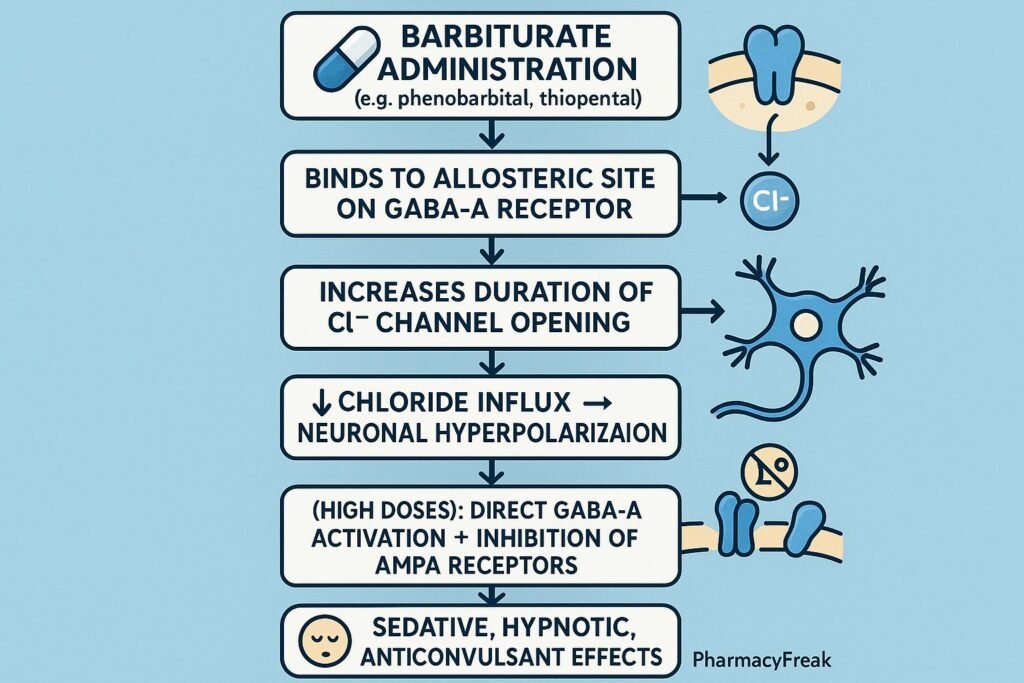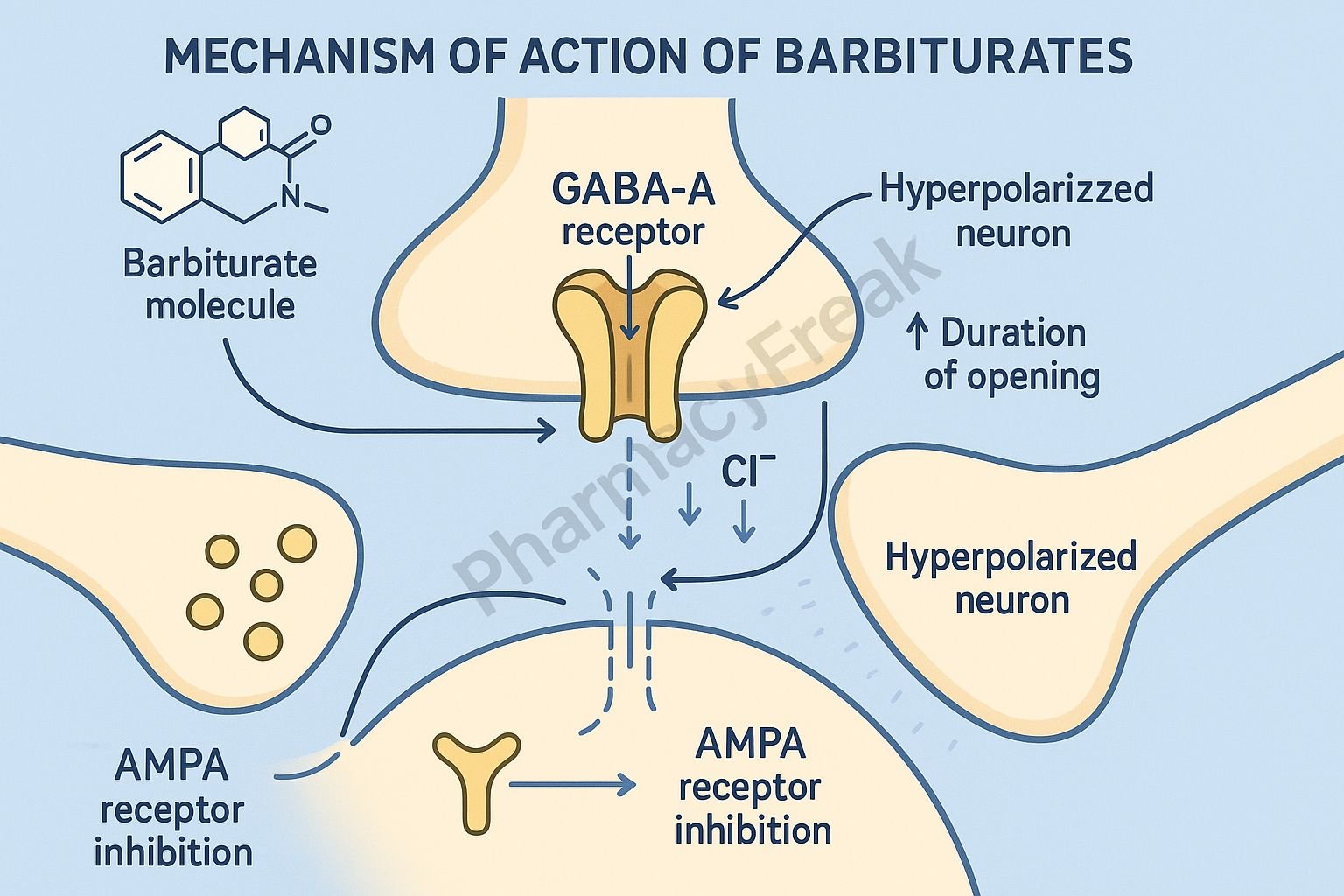Table of Contents
Introduction
Barbiturates are central nervous system (CNS) depressants historically used as sedatives, hypnotics, anesthetics, and anticonvulsants. Although their clinical use has decreased due to safer alternatives (benzodiazepines), they remain important in anesthesia and seizure management—particularly phenobarbital for epilepsy.
Barbiturates exert profound CNS depression by enhancing inhibitory GABAergic transmission, blocking excitatory neurotransmission, and directly suppressing neuronal activity at higher doses.
Mechanism of Action (Step-wise)
1. Potentiation of GABA<sub>A</sub> Receptor Activity
- Barbiturates bind to a distinct site on the GABA<sub>A</sub> receptor–chloride channel complex.
- They increase the duration of chloride channel opening when GABA binds.
- This leads to greater influx of Cl⁻ ions, causing:
- Hyperpolarization of neurons
- Reduced neuronal excitability
- CNS depression
Key Point:
Benzodiazepines increase frequency of channel opening; barbiturates increase duration.
2. Direct Activation of GABA<sub>A</sub> Receptors at High Doses
- At high concentrations, barbiturates directly open Cl⁻ channels even without GABA present.
- This can produce profound CNS depression leading to:
- Anesthesia
- Respiratory depression
- Coma
This explains their narrow therapeutic index compared to benzodiazepines.
3. Inhibition of Excitatory Neurotransmission (Glutamate Blockade)
- Barbiturates inhibit AMPA-type glutamate receptors, blocking excitatory synaptic transmission.
- Further contributes to sedation, anticonvulsant activity, and CNS depression.
4. Suppression of Voltage-Gated Sodium and Calcium Channels
- Barbiturates reduce neuronal firing by decreasing:
- Na⁺ channel activity
- Ca²⁺-dependent neurotransmitter release
This stabilizes neuronal membranes and enhances anticonvulsant action.
5. Overall Effects on CNS Physiology
| Mechanism | Outcome |
|---|---|
| ↑ Duration of GABA-mediated Cl⁻ channel opening | Sedation, hypnosis, anxiolysis |
| Direct GABA-mimetic action | Anesthesia, profound CNS depression |
| Inhibition of AMPA receptors | Reduced excitatory transmission |
| Inhibition of Na⁺/Ca²⁺ channels | Anticonvulsant effects |
| Dose-dependent depression | Sleep → Anesthesia → Coma |


Pharmacokinetics
- Absorption: Rapid oral and IV absorption.
- Distribution: Lipid-soluble (thiopental extremely rapid; used for induction of anesthesia).
- Metabolism: Hepatic (CYP450 induction).
- Excretion: Renal, increased with urinary alkalinization.
- Half-life: Long for phenobarbital (~100 hours).
Clinical Uses
- Seizure control: Phenobarbital for generalized and partial seizures.
- Status epilepticus: Second-line after benzodiazepines.
- Anesthesia induction: Thiopental, methohexital.
- Medically induced coma: To reduce intracranial pressure.
- Insomnia/anxiety: Historically used—rarely used now due to safety concerns.
Adverse Effects
- Severe CNS depression
- Respiratory depression
- Hypotension
- Sedation, ataxia, impaired cognition
- Tolerance and dependence
- Withdrawal (life-threatening seizures)
- CYP450 enzyme induction → drug interactions
- Teratogenicity
Comparative Analysis
| Feature | Barbiturates | Benzodiazepines |
|---|---|---|
| GABA effect | ↑ Duration of Cl⁻ opening | ↑ Frequency of Cl⁻ opening |
| Direct GABA activation | Yes (high dose) | No |
| Safety margin | Low | High |
| Risk of coma/death | High | Low |
| Enzyme induction | Strong | Minimal |
| Use today | Limited | Very common |
MCQs
1. Barbiturates enhance GABAergic transmission by:
a) Increasing Cl⁻ channel frequency
b) Blocking GABA receptors
c) Increasing duration of Cl⁻ channel opening
d) Inhibiting dopamine receptors
Answer: c) Increasing duration of Cl⁻ channel opening
2. At high doses barbiturates can:
a) Require GABA to act
b) Directly open GABA<sub>A</sub> channels
c) Block K⁺ efflux
d) Activate NMDA receptors
Answer: b) Directly open GABA<sub>A</sub> channels
3. The excitatory receptor inhibited by barbiturates is:
a) GABA<sub>A</sub>
b) AMPA
c) Dopamine D2
d) Serotonin 5-HT
Answer: b) AMPA
4. Phenobarbital is primarily used as:
a) Antidepressant
b) Anticonvulsant
c) Antipsychotic
d) Antihypertensive
Answer: b) Anticonvulsant
5. Barbiturates induce which enzyme system?
a) MAO
b) CYP450
c) COMT
d) Acetylcholinesterase
Answer: b) CYP450
FAQs
Q1. Why are barbiturates less safe than benzodiazepines?
Because they can directly activate GABA receptors, causing profound CNS and respiratory depression.
Q2. Do barbiturates cause tolerance?
Yes—both metabolic (CYP induction) and pharmacodynamic tolerance.
Q3. Which barbiturate is widely used for seizures?
Phenobarbital.
Q4. Can barbiturate overdose be fatal?
Yes, due to respiratory arrest and CNS depression.
Q5. Are barbiturates still used?
Yes, but mainly for seizures, anesthesia, and medically induced coma.
References
Goodman & Gilman’s The Pharmacological Basis of Therapeutics.
Katzung, Basic and Clinical Pharmacology.
Tripathi KD, Essentials of Medical Pharmacology.
Harrison’s Principles of Internal Medicine.

I am pursuing MBA in pharmaceutical management from NIPER Hyderabad with a strong academic record and proven success in national-level pharmacy entrance exams. I secured AIR 61 in NIPER 2024 (MS/M.Pharm) and AIR 27 in NIPER MBA, along with AIR 147 in GPAT 2024 and AIR 907 in GPAT 2023. I also achieved AIR 6 in AIIMS CRE-2025 for Drug Store Keeper and was selected as a Pharmacist (AIR 61) for ESIC. Additionally, I was the Runner-Up in Round 2 of the EY Case Study Competition.
At PharmacyFreak.com, I aim to guide future pharmacists through expert content, exam strategies, and insightful resources based on real experience and academic excellence.
Mail- harsh@pharmacyfreak.com

